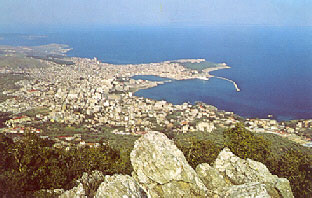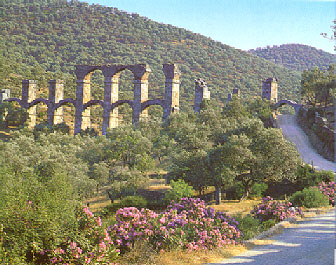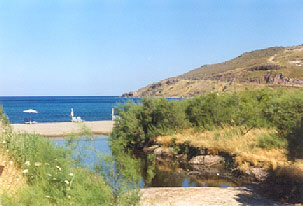|
Lesvos Island
 Greece's third largest island after Kriti and Evia, was a
center of the Aeolian civilization, when around the 10th
century B.C. it spread to the shores of Asia Minor. During the
reign of the tyrant Pittakos (6th century B.C.) - one of the
Seven Sages of Antiquity - Sappho and Alcaeus, two of the
greatest poets of the ancient world, immortalized the island
in their poetry. It has also been the birthplace of the
guitarist Arion and the musician Terpandros.
Greece's third largest island after Kriti and Evia, was a
center of the Aeolian civilization, when around the 10th
century B.C. it spread to the shores of Asia Minor. During the
reign of the tyrant Pittakos (6th century B.C.) - one of the
Seven Sages of Antiquity - Sappho and Alcaeus, two of the
greatest poets of the ancient world, immortalized the island
in their poetry. It has also been the birthplace of the
guitarist Arion and the musician Terpandros.
In the 5th
century B.C., Lesvos joined the Athenian League but, like the
other Greek states, succumbed to Macedonia in the following
century. In 88 B.C., it was annexed to the Roman province of
Asia Minor. In later years, it was ruled succesively by the
Byzantines (1355), the Genoese (1462) and the Turks
(1462-1912), while repeated pirate raids over the centuries
caused the islanders to erect countless castles in
self-defence.
 Its long,
unbroken high standard of civilization is still in evidence;
even in our own day many outstanding writers, artists and
thinkers have their roots in Lesvos. The list is impressive:
Stratos Eleftheriades (Teriade), scholar, publisher and art
critic, the self taught naif painter Theophilos
(Hadzimichail), novelists Argyris Eftaliotis and Stratis
Myrivillis, poet Stratis Paschalis, who won the 1st prize of
the Academy of Athens at the age of 35 (usually people get
this award at the age of 70) and Greece's most famous
contemporary poet, the Nobel laureate Odysseas Elytis. Its long,
unbroken high standard of civilization is still in evidence;
even in our own day many outstanding writers, artists and
thinkers have their roots in Lesvos. The list is impressive:
Stratos Eleftheriades (Teriade), scholar, publisher and art
critic, the self taught naif painter Theophilos
(Hadzimichail), novelists Argyris Eftaliotis and Stratis
Myrivillis, poet Stratis Paschalis, who won the 1st prize of
the Academy of Athens at the age of 35 (usually people get
this award at the age of 70) and Greece's most famous
contemporary poet, the Nobel laureate Odysseas Elytis.
Lesvos is
one of the few places in this country where most of its towns
and villages have preserved intact their architectural
herritage. Among its most remarkable treasures are the old
olive presses, which for some years now are being restored and
converted into cultural centers.
 The deeply
indented bays of Kalloni and Yera almost split the island into
three parts, creating fertile valleys between them. The
highest mountains are Lepetymnos (968m.) and Olympos (967m.).
Most of the towns and villages were built in the interior for
security reasons, in the dips and hollows of its undulating
hills. The deeply
indented bays of Kalloni and Yera almost split the island into
three parts, creating fertile valleys between them. The
highest mountains are Lepetymnos (968m.) and Olympos (967m.).
Most of the towns and villages were built in the interior for
security reasons, in the dips and hollows of its undulating
hills.
The
landscape is astonishingly varied, with enormous olive groves
- their 11 million trees produce a vast quantity of justly
famous
- pine - covered slopes interspersed with oak, chestnut and
plane trees, rocky mountains, numerous beaches, some sandy,
some pebbly, some with steam rising from them indicating the
presence of hot springs, some - the ones facing the open sea -
blessed with crystalline waters. |